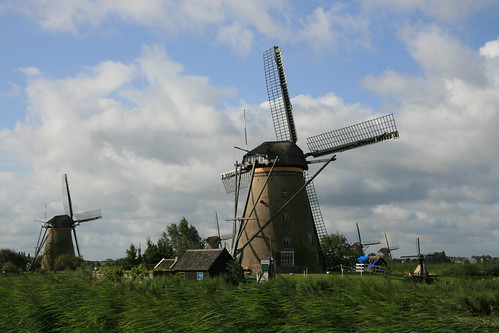The Netherlands is the country of windmills, cheese and tulips. Almost any tourist souvenir is accompanied by one of three icons. In this article we will focus on the former. Throughout his entire geography Holland is dotted with them, here and there we see everywhere and I do not mean those horrible mills used to produce energy that do so much damage to the landscape. Currently the list of historic windmills reaches a thousand.

Photography by malex.org
But talking of mills Netherlands has a unique place in the world in which they took very seriously the matter of sheer necessity. In the thirteenth century Alblasserwaard problems became untenable. The area suffered from constant flooding which hampered the lives of its inhabitants as the endangered salt water their crops and therefore their livelihood. Initially built canals to evacuate excess water into the river Lek. Unfortunately, this idea was not enough and took a much more radical. Decided to build a series of mills that would act as pumps for the drainage of water. Kinderdijk’s landscape is composed of 19 mills. The first 16 are from 1738 and 1740. Currently the drainage work has been undertaken by modern pumping stations and the mills have been converted into homes.
Kinderdijk:
Kinderdijk The Dutch name literally means «Dock of the Child» and comes from a very curious story. It turns out that during the flooding of St. Elizabeth in 1421 the agricultural region of Grote Hollandse Waard was completely under water. Alblasserwaard safe from disaster is staying dry. It is said that when the storm subsided someone came to the dike that protected the area to see what could be saved. This person noticed that the distance was a floating wooden cradle. There was hope there was someone alive inside but could see some movement on it. When the cradle came closer she saw a cat on trying to maintain balance jumping from one extreme to another. When the cradle came ashore was surprised to see a baby inside asleep and completely dry. The cat had saved his life.

Photography by where are the joneses
Kinderdijk, this engineering marvel was recognized in 1997 by UNESCO, incorporating Kinderdijk to its list of World Heritage sites by:
«The contribution of the population of the Netherlands to the development of techniques for drainage of water is enormous, as demonstrated admirably facilities Kinderdijk-Elshout area. Hydraulic works to drain land for agriculture and settlement of populations in reclaimed lands began in the Middle Ages and has continued unabated to this day. The site includes all the characteristic features of the technology of drainage, dams, reservoirs, pumping stations, administrative buildings and a series of impeccably preserved windmills».
Leave a Reply
You must be logged in to post a comment.
Recent Comments